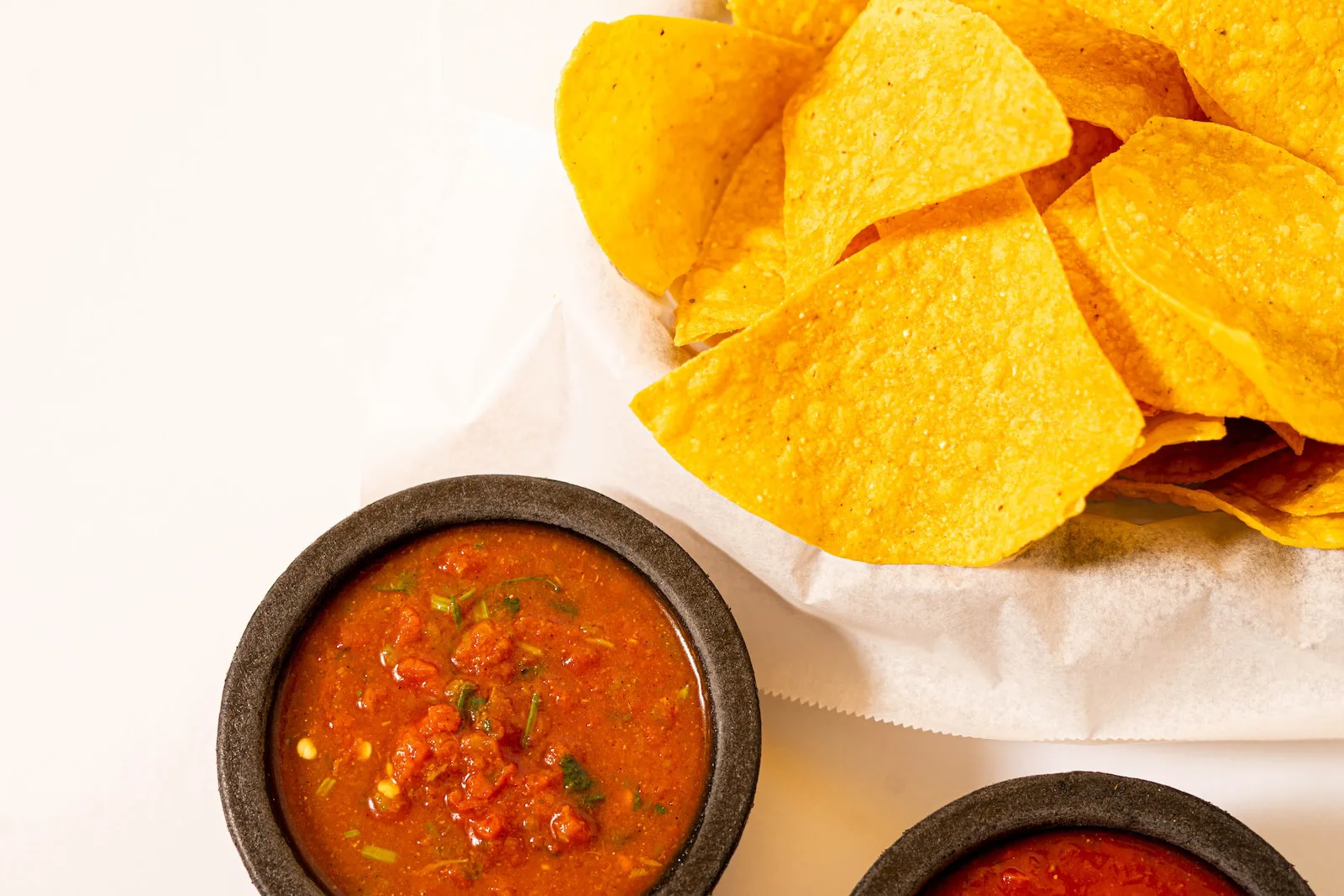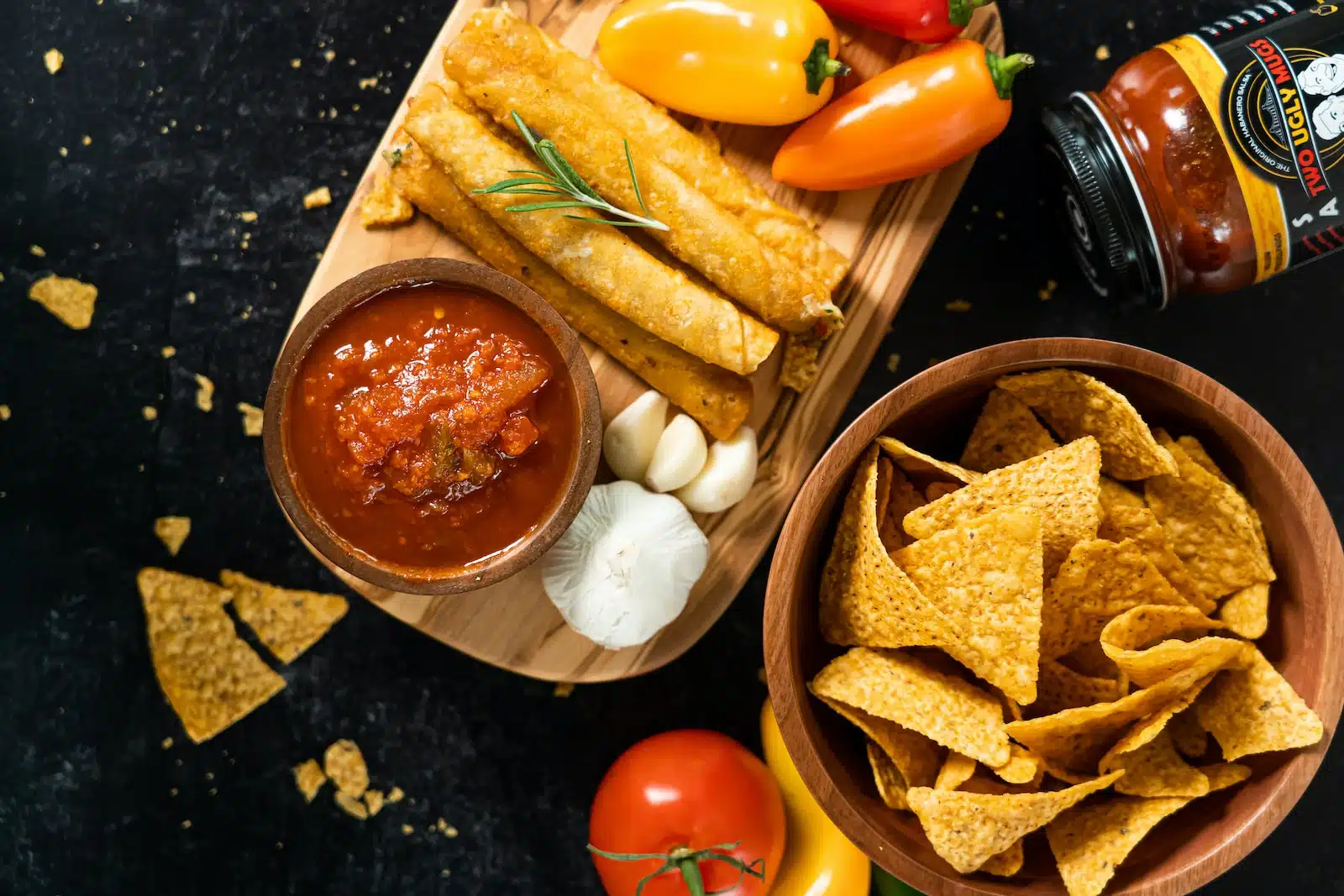Have you ever crafted a batch of salsa that’s hotter than you bargained for, leaving your taste buds feeling like they’ve gone through a trial by fire? You’re certainly not the only one.
The thrill of making homemade salsa is often coupled with the risk of overestimating our love for heat. Picture this: you’re at your kitchen counter, peppers in hand, anticipating the blend of flavors, but then – bam. Your tangy treasure is more volcanic than vibrant.
Fear not, fellow spice warriors; there’s no reason to bid farewell to that zesty labor of love just yet. After trawling through cookbooks and channeling my inner food scientist with some good old kitchen wizardry, I’m excited to share some tried-and-true tactics to bring down the burn.
We’ll talk about how something as simple as lime juice doesn’t just provide a pop of flavor—it’s also got citric acid that works wonders in softening the edge of an overly fiery dish.
So, let’s get ready to take your scorching hot salsa from mouth-scorching to mellow magic everyone can enjoy!
Key Takeaways
- If your salsa is too hot or spicier than you thought, try diluting it with some water or broth; this will tone down the heat without losing the overall flavor.
- You can also add acidic ingredients like lime juice, lemon juice, or vinegar to cut through the spiciness and give a zesty kick to your salsa.
- To balance out the spice level in salsa without messing it up, sweeten it up by adding a pinch of sugar, honey, or fruits such as mangoes and pineapples for natural sweetness.
- Adding dairy products like sour cream, yogurt, or milk can help neutralize capsaicin’s heat in spicy salsas and bring a creamy texture to the dish.
- Don’t forget to taste test the spicy food. Adjusting the spiciness as you go along is key—try introducing mild ingredients like bell peppers and increase non-spicy components till you get that perfect taste.
Understanding Salsa and its Spiciness

Salsa is a popular Mexican condiment made from ingredients like tomatoes, onions, and peppers. The spiciness of salsa comes from capsaicin, the compound found in chili peppers that creates heat.
What is Salsa?
Salsa is a vibrant and versatile condiment that has its roots deeply embedded in Latin American cuisine. Typically, it combines tomatoes, onions, chili peppers, and various seasonings to create a flavor-packed sauce or dip.
It can range from mild to hot, depending on the type and amount of chili used.
My homemade salsa often includes fresh cilantro for an aromatic touch, perhaps some garlic for depth of flavor, and always a squeeze of lime juice to brighten everything up. When I’m feeling adventurous, I toss in fruits like mango or pineapple to introduce a sweet contrast that tames the heat.
Each ingredient plays a crucial role in crafting a well-balanced salsa — whether I want it fiery or more on the mild side.
I frequently customize my salsa recipe by adjusting ingredients based on who will be enjoying it. If there’s too much spice for my taste buds or those of my guests, adding extra tomatoes reduces the heat without sacrificing the salsa’s robust essence.
Every addition is deliberate, ensuring each spoonful pleases everyone’s palate while still delivering that unmistakable zesty kick characteristic of good salsa.
The Role of Capsaicin in Making Salsa Spicy
Salsa gets its heat from capsaicin, a compound found in chili peppers. When these peppers are added to salsa, the capsaicin binds to receptors in our taste buds, triggering the sensation of spiciness.
As a result, the more capsaicin present in the salsa, the hotter it will be. This is why understanding how capsaicin functions can help us effectively reduce the spiciness of salsa.
To break it down simply, when you add spicy chili peppers containing capsaicin to your salsa recipe, you’re amplifying its heat level.
6 Ways to Reduce Spiciness in Salsa

Diluting with water or broth can help tone down the heat in salsa while adding acidic ingredients like lime juice or vinegar can also balance out the spiciness. Adding sweetness, fried onions, dairy products, and citrus are all great options for reducing the spicy kick in your salsa.
Diluting with Water or Broth
To reduce the spiciness of salsa, diluting it with water or broth can effectively tone down the heat. This method involves adding small amounts of water or broth to the salsa and mixing thoroughly until it reaches the desired mildness.
By gradually diluting the salsa, you can maintain its flavor while reducing its spiciness, creating a more enjoyable taste for those with milder preferences.
Adding liquid components like water or broth also increases the overall volume of your salsa, making it an ideal approach for adjusting larger batches. It’s crucial to incorporate these liquids slowly and taste-test frequently to ensure that you achieve your preferred level of spiciness without compromising on flavor.
Adding Acidic Ingredients Like Lime Juice or Vinegar
To cool down the heat of overly spicy salsa, adding acidic ingredients like lime juice or vinegar can work wonders. The acidity helps to balance out the spiciness and enhance the overall flavor profile of the salsa.
You can also add extra tomatoes, lemon juice, or even a dash of apple cider vinegar to increase the acidity level in your salsa and reduce its spiciness. These acidic ingredients not only tone down the heat but also add a refreshing, tangy kick to your mild salsa recipe.
Increasing the acidity level with lime juice or vinegar not only reduces spiciness but also amplifies the flavors, giving your homemade salsa a well-rounded taste that will leave everyone wanting more.
Adding Sweetness
One way to reduce the spiciness in salsa is by adding sweetness. A pinch of sugar or a teaspoon of honey can help balance out the heat, creating a pleasant flavor profile. You can also incorporate fruits like mango, pineapple, or peach into the salsa to not only reduce spiciness but also add a hint of sweetness and tangy undertones.
The addition of these sweet components can effectively counteract the spicy kick, allowing you to enjoy a flavorful and milder salsa that suits your taste preferences.
Incorporating sweet ingredients into your salsa provides an excellent opportunity to adjust its overall flavor balance. By experimenting with different levels of sweetness from various sources, such as fruits, sugar, or honey, you have the flexibility to customize the taste according to your liking.
Adding Fried Onions
To reduce the spiciness of salsa, I sometimes add a handful of fried onions, as they provide a rich, savory flavor that complements the heat. Onions contain natural sugars that can help balance out the spice level and add depth to the overall taste.
Additionally, frying onions brings out their sweetness and mellows their sharpness, which can help tone down the spiciness of the salsa while enhancing its flavor profile.
Furthermore, adding fried onions creates a textural contrast in the salsa, providing a satisfying crunch alongside other ingredients. It’s important to adjust the amount of fried onions based on personal preference and taste testing to achieve the desired balance of flavors when toning down spicy salsa.
Using Dairy Products
Adding dairy products to salsa is a great way to temper its spiciness while also bringing creaminess and richness to the flavor profile. Ingredients like sour cream, yogurt, or even a splash of milk can help mellow out the heat of the salsa.
The fat content in these dairy products helps to counterbalance the capsaicin from the spicy ingredients, creating a smoother and more mild overall taste.
Introducing dairy into your salsa not only reduces its spiciness but also adds a delightful texture and depth of flavor. It’s important to note that different types of dairy products can bring varying levels of creaminess and tang, so experimenting with small quantities is crucial before finding the perfect balance for your customized salsa creation.
Adding Citrus
Adding citrus to salsa can help balance out its spiciness and enhance its flavor profile. The acidity of citrus fruits such as lime, lemon, or orange juice can help cut through the heat of the peppers in the salsa.
It also adds a refreshing, tangy taste that complements the other ingredients well. Additionally, citrus fruits not only reduce spiciness but also bring a bright and vibrant element to the overall flavor of the salsa.
Lemon or lime juice is an essential tool in combating excessive heat in salsa because it has a pH level between 2 and 3, which helps neutralize capsaicin’s alkaline properties. This process effectively decreases the perceived spiciness while enhancing other flavors present within your homemade recipe for mild tomato-based salsas.
Substituting some of your tomato elements with freshly squeezed orange or grapefruit juices provides both natural sweetness and acidity without risking overpowering heat levels – thus creating an exceptional yet balanced addition to your personalized mild variant.
The Importance of Tasting and Adjusting

Tasting and adjusting the spiciness level of your salsa is crucial to achieving the perfect balance of flavors. It’s important to taste as you go and make small adjustments to ensure that your salsa is enjoyable for everyone.
How to Taste and Adjust the Spiciness Level?
To taste and adjust the spiciness level, start by taking a small spoonful of the salsa and letting it rest on your tongue. Carefully note the initial heat level and then follow these steps to balance the spiciness:
- Add acidity: Squeeze in some lime or lemon juice to reduce the overall spiciness. The acidic components will help to neutralize the heat.
- Sweeten it up: Incorporate a touch of sugar or honey to counteract the spiciness while adding a hint of sweetness to your salsa.
- Introduce fruits: Mix in diced mango, pineapple, or peach to offer a tropical twist while lowering the overall heat.
- Creamy additions: Consider adding avocado or dairy products like sour cream or Greek yogurt to tame the spiciness and add creaminess.
- Dilution with other ingredients: If needed, mix in additional diced tomatoes, black beans, or corn to dilute and soften the spice level.
- Play with other flavors: Experiment with various mild ingredients, such as bell peppers or cucumber, to balance out the heat factor effectively.
- Adjust tomato content: For red-based salsas, increasing the amount of tomatoes can mellow out the spiciness and create a more balanced flavor profile.
- Mind non-spicy ingredient ratio: Increasing non-spicy components relative to spicy ones can help you achieve that perfect equilibrium of flavors.
- Tweak according to personal taste: Since different recipes and individual preferences vary, don’t hesitate to experiment until you find your ideal level of mildness.
Common Mistakes to Avoid
Common mistakes to avoid when making salsa less spicy include adding too much water or broth, which can dilute the flavor of the salsa. Using too much dairy product may make the salsa too creamy and mask its flavors.
Overusing citrus ingredients might make the salsa overly tangy instead of balancing out the spiciness. Avoiding tasting and adjusting as you go along can lead to an excessively spicy or bland final product.
Failing to consider personal preferences and individual recipe needs could result in ineffective adjustments for reducing spiciness in your salsa.
Ways to Customize Your Salsa

Adding in additional ingredients like tomatoes, cucumber, avocado, or even fruit can add new flavor dimensions to your salsa. Experiment with different levels of spiciness and see what combination works best for you.
Add in Additional Ingredients Like Tomatoes, Cucumber, Avocado, Etc.
To make salsa less spicy, incorporating additional ingredients like tomatoes, cucumber, avocado, or mango can help balance out the heat. These ingredients not only dilute the spiciness but also contribute to a more complex flavor profile.
For instance, adding diced tomatoes adds freshness and acidity to the salsa while helping to reduce its overall spiciness. Cucumbers bring a refreshing crunch and mildness that can counteract the heat of the peppers in the salsa.
Furthermore, avocados are rich and creamy, which helps mellow down the spiciness of salsa while providing a delightful texture. The addition of fruits such as mango or peach can infuse natural sweetness into the salsa while mitigating its spiciness level.
Experimenting with Different Levels of Spiciness
Experimenting with different levels of spiciness in salsa can be a fun and creative process. By adjusting the ratio of spicy ingredients to milder ones, you can tailor the heat level to your preference.
Adding varying amounts of acidic or sweet elements allows for customization, whether you prefer a mild flavor or enjoy a bit of kick. Trying out diverse combinations not only helps to find your perfect balance but also adds depth to the overall flavor profile.
It’s all about finding the right mix that suits your taste buds while exploring new ways to enhance your homemade salsa.
FAQs
How can I reduce the heat level in my homemade salsa?
To make your salsa less spicy, adjust the salsa spice reduction by removing some of the seeds from peppers or use milder salsa seasoning options.
Are there ingredients I can add to tone down the spiciness of my salsa?
Yes, adding creaminess with ingredients like avocado or sour cream will balance out the spiciness and create a milder flavor in your tomato salsa.
What should I do if my fresh salsa is too hot for my taste?
For a too-hot batch of fresh salsa, you can dilute the heat by adding more tomatoes or other non-spicy vegetables to enhance the overall flavor without increasing spiciness.
Can I make mild salsa recipes at home even after it’s already made spicy?
Absolutely! Modify existing spicy homemade salsas into mild versions by incorporating additional mild ingredients and adjusting seasoning to achieve the desired flavor balance.
What are some tips for enhancing flavor while reducing heat in homemade salsas?
Experiment with different Salsa ingredient substitutions, such as sweet bell peppers or fruits; these contribute to creating flavorful but not overly hot Salsa variations.
Conclusion
We’ve learned various practical strategies for making salsa less spicy. These methods are easy to implement and can significantly reduce the heat while enhancing the flavor.
Have you considered how these techniques could elevate your homemade salsa? Diluting with water or broth, adding acidic ingredients like lime juice or vinegar, and experimenting with different levels of spiciness can lead to a milder but flavorful outcome.
By incorporating these adjustments, you can transform overly spicy salsa into a delicious and balanced condiment that everyone will enjoy. So go ahead, give these approaches a try, and savor the delightful results.

